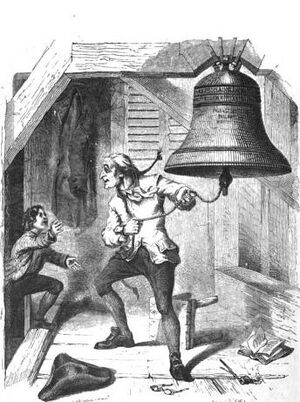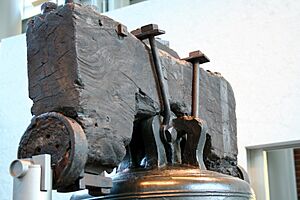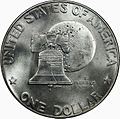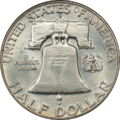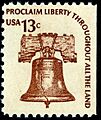Liberty Bell facts for kids
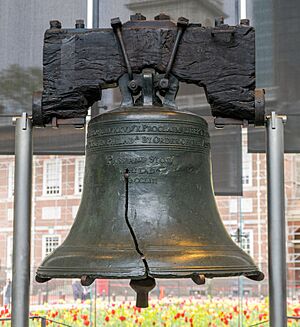
The Liberty Bell outside Independence Hall in Philadelphia in April 2017
|
|
| Coordinates | 39°56′58″N 75°9′1″W / 39.94944°N 75.15028°W |
|---|---|
| Location | Liberty Bell Center Philadelphia, Pennsylvania, U.S. |
| Designer | Whitechapel Bell Foundry |
| Type | Tower bell |
| Material | 70% Copper, 20% Tin, 10% other metals |
| Width | 3.82 ft (1.16 m) (circumference is 12 ft (3.7 m) around the lip, 7.5 ft (2.3 m) around the crown) |
| Height | About 4 ft (1.2 m) |
| Completion date | 1752 |
| 2,080 pounds (940 kg) | |
The Liberty Bell, originally known as the State House Bell, is a famous symbol of American independence located in Philadelphia. It was first hung in the Pennsylvania State House, now called Independence Hall, and is currently displayed in the Liberty Bell Center across the street.
Commissioned in 1752 by the Pennsylvania Provincial Assembly, the bell features the inscription "Proclaim LIBERTY Throughout all the Land unto all the Inhabitants Thereof," which references a verse from the Bible (Leviticus 25:10). After arriving in Philadelphia, it cracked upon being rung and was recast twice by local craftsmen John Pass and John Stow. Initially, it was used to call lawmakers to sessions and announce public events.
After World War II, the National Park Service took custody of the Liberty Bell while Philadelphia retained ownership. The bell has become a symbol of freedom and has been a site for protests. It was moved to its current location in 2003. Over time, it has appeared on coins and stamps and has been widely used in various commercial contexts.
Contents
History
Philadelphia's city bell had been used to alert the public to proclamations or civic danger since the city's 1682 founding. The original bell hung from a tree behind the Pennsylvania State House, now known as Independence Hall, and was said to have been brought to the city by its founder, William Penn. In 1751, civic authorities sought a bell of better quality that could be heard at a greater distance in the rapidly expanding city. Isaac Norris, speaker of the Pennsylvania Provincial Assembly, gave orders to the colony's London agent, Robert Charles, to obtain a "good Bell of about two thousands pound weight".
Robert Charles ordered the bell from Thomas Lester of the London bellfounding firm of Lester and Pack, later known as the Whitechapel Bell Foundry, for £150 13s 8d, (equivalent to £18,976 in 2021 ) including freight to Philadelphia and insurance on its transport. It arrived in Philadelphia in August 1752.
The bell was mounted on a stand to test the sound, and at the first strike of the clapper, the bell's rim cracked. Philadelphia authorities tried to return it by ship, but the master of the vessel that had brought it was unable to take it on board.
Two local founders, John Pass and John Stow, offered to recast the bell. The bell was broken into small pieces, melted down, and cast into a new bell. The two founders decided that the metal was too brittle, and augmented the bell metal by about ten percent, using copper. By March 1753, the bell was ready.
City officials in Philadelphia scheduled a public celebration with free food and drink for the testing of the recast bell. When the bell was struck, it did not break, but the sound produced was described by one hearer as similar to that of two coal scuttles being banged together. Mocked by the crowd, Pass and Stow hastily took the bell away to again recast it. In June 1753, the recasting was completed, and the sound was deemed satisfactory, though Norris indicated that he did not personally like it. The bell was hung in the steeple of the State House the same month.
American Revolution


Dissatisfied with the bell, Norris instructed Charles to order a second one, and see if Lester and Pack would take back the first bell and credit the value of the metal towards the bill. In 1754, the Assembly decided to keep both bells; the new one was attached to the tower clock while the old bell was used to summon the Assembly.
As the American Revolutionary War intensified, delegates to the Second Continental Congress and colonial-era city officials and citizens of Philadelphia were acutely aware that the British Army would likely recast the bell into munitions if they were able to find and secure it. On September 11, 1777, these concerns escalated after Washington and the Continental Army were defeated in the Battle of Brandywine, leaving the revolutionary capital of Philadelphia defenseless. The city urgently prepared for an inevitable British attack. The Liberty Bell and other major bells in Philadelphia were hastily taken down from their towers, and sent by heavily guarded wagon train to Bethlehem and then to Zion German Reformed Church at 622 Hamilton Street in Allentown, Pennsylvania, then known as Northampton Towne. In Allentown, the Liberty Bell was hidden under the church's floor boards just as the British were entering and beginning their occupation of Philadelphia.
The bell remained hidden in Allentown for nine months. In June 1778, following the British retreat from Philadelphia on June 18, 1778, it was returned. Upon the bell's return to Philadelphia, the steeple of the State House was in poor condition, and was subsequently torn down and restored. The bell was placed in storage until 1785, when it was again mounted for ringing.
Following the victory of Washington and the Continental Army in the Revolutionary War, the bell was placed on an upper floor of the State House, and was rung on Independence Day, on Washington's Birthday, and on Election Day to remind voters to hand in their ballots. It also rang to call students at the University of Pennsylvania to their classes at nearby Philosophical Hall. Between 1785 and 1799, when the Pennsylvania state capital was briefly moved to Lancaster, it was rung to summon state legislators into session. When Pennsylvania, having no further use for its State House, proposed to tear it down and sell the land for building lots, the City of Philadelphia purchased the land, the State House, and the Liberty Bell, for $70,000, equal to $1,207,020 today.
19th century
It has not been definitively determined when or how the Liberty Bell first came to be cracked, but it is known that the damage occurred in the early 19th century, sometime between 1817 and 1846 and likely toward the end of this period.
In 1848, with the rise of interest in the bell, the city decided to move it to the Assembly Room, also known as the Declaration Chamber, on the first floor, where the Declaration and United States Constitution had been debated and signed. The city constructed an ornate pedestal for the bell. The Liberty Bell was displayed on that pedestal for the next quarter-century.
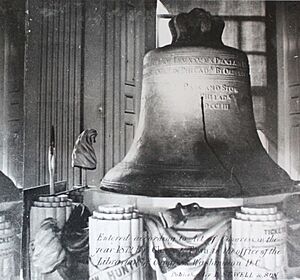
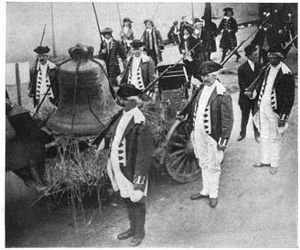


In 1876, Philadelphia city officials discussed what role the bell should play in the nation's Centennial festivities. Some wanted to repair it so it could sound at the Centennial Exposition being held in Philadelphia, but the idea was not adopted. The bell's custodians concluded that it was unlikely that the metal could be made into a bell that would have a pleasant sound, and that the crack had become part of the bell's character. Instead, a replica weighing 13,000 pounds (5,900 kg), representing 1,000 pounds for each of the Thirteen Colonies, was cast. The metal used for what was dubbed "the Centennial Bell" included four melted-down cannons: one used by each side in the American Revolutionary War, and one used by each side in the American Civil War. The bell was rung at the Exposition grounds on July 4, 1876, and was later recast to improve the sound. The bell is currently attached to the clock in the steeple of Independence Hall.
Between 1885 and 1915, the Liberty Bell was transported to seven expositions and celebrations. Each time, the bell traveled by railroad, and an extra number of rail stops were made along way so that local people could view it. By 1885, the Liberty Bell was widely recognized as a symbol of freedom, and as a treasured relic of independence and freedom. Large crowds mobbed the bell at each stop.
Philadelphians began to cool to the idea of sending it to other cities when it returned from Chicago bearing a new crack, and each new proposed journey met with increasing opposition. It was also found that the bell's private watchman had been cutting off small pieces for souvenirs. Philadelphia placed the bell in a glass-fronted oak case.
In 1898, it was taken out of the glass case and hung from its yoke again in the tower hall of Independence Hall, a room that would remain its home until the end of 1975. A guard was posted by the bell to prevent souvenir hunters who might otherwise chip at it.
By 1909, the bell was sent on six trips. The bell's cracking worsened, and souvenir hunters had chipped off pieces of it, depriving it of over one percent of its weight. Its weight was reported as 2,080 lb (940 kg) in 1904.
20th century

After World War II, the City of Philadelphia agreed that it would transfer custody of the bell and Independence Hall, while retaining ownership, to the federal government.
In the postwar period, the bell became a symbol of freedom used in the Cold War. During the 1960s, the bell was the site of several protests, both for the civil rights movement, and by various protesters supporting or opposing the Vietnam War.
Liberty Bell Center
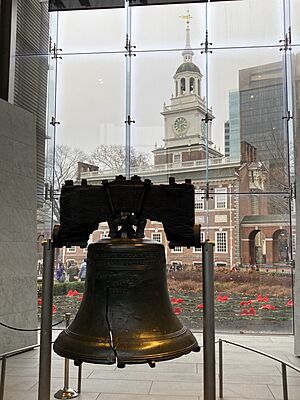
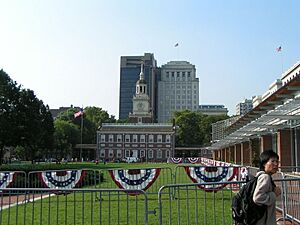

In 1995, the Park Service began preliminary work on a redesign of Independence Mall. The Olin Partnership was hired to create a new master plan for Independence Mall; its team included architect Bernard Cywinski, who ultimately won a limited design competition to design what was called the Liberty Bell Center (LBC). Cywinski's design was unveiled in early 1999. Significantly larger than the existing pavilion, allowing for exhibit space and an interpretive center, the proposed LBC building also would cover about 15% of the footprint of the long-demolished President's House, the "White House" of George Washington and John Adams.
The new facility that opened hours after the bell was installed on October 9, 2003, is adjacent to an outline of Washington's slave quarters marked in the pavement. The GPS address is 526 Market Street.
Inside the Liberty Bell Center, visitors pass through a number of exhibits about the bell before reaching the Liberty Bell itself.
Legacy and commemorations
As part of the Liberty Bell Savings Bonds drive in 1950, 55 replicas of the Liberty Bell (one each for the 48 states, the District of Columbia, and the territories) were ordered by the United States Department of the Treasury and were cast in France by the Fonderie Paccard. The bells were to be displayed and rung on patriotic occasions. Many of the bells today are sited near state capitol buildings.
The Liberty Bell appeared on a commemorative coin in 1926 to mark the sesquicentennial of American independence. Its first use on a circulating coin was on the reverse side of the Franklin half dollar, struck between 1948 and 1963. It also appeared on the Bicentennial design of the Eisenhower dollar, superimposed against the moon.
On the 150th anniversary of the Declaration of Independence in 1926, the U.S. Post Office issued a commemorative stamp depicting the Liberty Bell for the Sesquicentennial Exposition in Philadelphia in 1926, though this stamp actually depicts the replica bell erected at the entrance to the exposition grounds.
Interesting facts about the Liberty Bell
- The Liberty Bell now weighs 2,080 pounds (940 kg).
- Its metal is 70% copper and 25% tin, with the remainder consisting of lead, zinc, arsenic, gold, and silver.
- While it is often believed that the Liberty Bell rang on July 4, 1776, when the Declaration of Independence was read, there is no solid evidence to confirm this.
- The bell developed its large crack after many years of use; a significant widening occurred in 1846 during a celebration for George Washington's birthday.
- Walt Disney World has a replica of the Liberty Bell that is in Liberty Square in the Magic Kingdom. The replica was cast from the mold of the actual Liberty Bell in 1989.
- An image of the Liberty Bell appears on the current $100 note. The image changes color, depending on the angle at which it is held.
Images for kids
-
Bicentennial dollar, 1976 issue, reverse
See also
 In Spanish: Campana de la Libertad para niños
In Spanish: Campana de la Libertad para niños
- Liberty Bell Memorial Museum, located in Melbourne, Florida
- Liberty Bell Ruby, a massive ruby sculpted into the shape of the Liberty Bell
- Margaret Buechner composed a work for chorus and orchestra, Liberty Bell, that incorporates a 1959 recording of the actual bell made by Columbia Records.
- Freedom Bell in Berlin, Germany – given as a gift from Americans to the city of Berlin in 1950 as a symbol of the fight for freedom and against communism in Europe
- The superhero Liberty Belle whose powers are derived from the ringing of the bell.
- The Freedom Bell, American Legion, a two times replica resides in front of Union Station in Washington, D.C., and toured the United States aboard the 1975–76 Bicentennial American Freedom Train.
- The Rhodesian Independence Bell, a replica of the Liberty Bell funded by American donors to commemorate Rhodesian independence
- The Tsar Bell, an early 18th-century Russian bell famous for its massive size and its damaged state


